It is my opinion that the traditionalist movement in the United States is evolving into a more profound understanding of the evil it is facing. It is also realizing its own strength and its possibilities to stop the march of Progressivism in the Catholic Church. This deeper comprehension demands a consistent explanation of the phenomenon that caused the present day crisis in the Catholic Church and in Christendom.
Revolution and Counter-Revolution are terms that are being adopted by conservatives and traditionalists to describe such phenomenon. Even though often the word Revolution is correctly used, applications can lack the full extension the term implies. Let me give some examples.
Different uses of the word Revolution
Some persons, and I include myself among them, had suggested the term Revolution to describe the subversion Vatican Council II caused in the previous order and stability of the Catholic Church. The expression “revolution” in relation to the Council has been utilized in the same sense even by the leaders of Progressivism such as Cardinal Congar and Cardinal Suenens (1). Therefore, it is appropriate to employ the word revolution to the post-Conciliar reforms. But in this application a few questions remain to be answered:
- If Vatican II is the Revolution, what is the Counter-Revolution? Is it Traditionalism? Is it the conservative tendency among Catholics?
- Who can say that he or she is a real counter-revolutionary?
- What prepared the way for Vatican II? Was it a current, an articulated movement?
- If there was, in fact, something before Vatican II, can the term Revolution also refer to that?
One sees that this first application of Revolution and Counter-Revolution opens the door to a historic perspective that invites investigation.
1. See my Animus Delendi I (Los Angeles: TIA, 2000), p. 54, note 14.
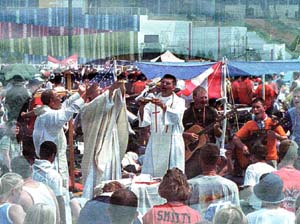
Masses like the one above at a WYD are revolutionary - The Leaven, August 23, 2002 |
Other persons have proposed a more narrow understanding of these concepts. For example, they use Revolution and Counter-Revolution to express exclusively the struggle against the New Mass that took the place of the Tridentine Mass as the primary act of worship to God. In this case, the Revolution would be the installation of the New Mass in the Liturgical Reform of Paul VI, and the Counter-Revolution would be to fight for the restoration of the Tridentine Mass. Period. Nothing more would be required, not even an analysis of the Liturgical Reform in which the New Mass is included, or of the Council that generated it.
Although I agree that such an application is legitimate, it is faulty by its simplification. It insinuates that this explains the whole revolution inside the Church, when this is not true. Actually, the New Mass is one important facet of the “conciliar revolution,” but no one with a broader vision, even among the progressivists, would define the whole scenario as the fight between the Tridentine Mass versus the New Mass.
Others have proposed different interpretations of the term revolution that mix together many concepts.
On one hand, Revolution is understood as a confused mixture of the cultural revolution of the ‘60s along with characteristics of Americanism. Traditionalists who use the term as such understand Americanism as the casual way of being of the late ‘40s and ‘50s in the United States that produced a great change – a revolution – in the traditional customs of Western man. Some of the avenues that spread this cultural revolution were Hollywood and the media, which diffused en masse American items such as neon lights, plastic, blue-jeans, rock ’n’ roll, and Coca-Cola.
On the other hand, some writers identify Revolution with certain moral issues, such as the international promotion of abortion and birth control by certain financial institutions based in the U.S. In their understanding of Revolution, they also include the promotion of degenerate customs and free love by American movies and television.
To make the picture even more chaotic, in several of these acceptations, Americanism is wrongly confused with the heresy of Americanism condemned by Pope Leo XIII, which actually has a completely different meaning.
Here I don’t intend to go through all the incomplete or wrong interpretations that have been suggested to explain Revolution and Counter-Revolution in the conservative and traditionalist milieus in the United States. The very attempt to adopt such terms, in my opinion, is something positive. It would seem to indicate that the conservative and traditionalist movements are beginning to seek the deeper historical and philosophical roots to explain their fight for the Catholic cause. This very understandable aspiration reveals health and consistency. Since minds seem ripe to assimilate a more complete notion of these concepts, let me try to help them and explain the full meaning of Revolution and Counter-Revolution according to serious and renowned Catholic authors.
Revolution, a concept that comes from the 19th century
The notion of Revolution as a centuries-old phenomenon, which is what I will expound, was defined by European Catholics of the 19th century who took part in the glorious “ultramontane” movement. What was the ultramontane movement, which literally means, beyond the mountains? Catholics in France took a very good position against Gallicanism, a bad nationalist movement that wanted to separate the French Catholic Church from the Papal authority. The Catholics who were faithful to the Pope and Rome, which in respect to France lay beyond the Alps, took the name of ultramontane.
The ultramontane movement extended throughout Europe. Its first aim was to combat Liberalism inside the Catholic Church. Liberalism was the son of the Enlightenment and the French Revolution, and the most modern expression of the Revolution at that time. To indicate just a few of the most illustrious Catholics who spoke about the Revolution and fought against it, I can cite Donoso Cortes in Spain, Fr. Taparelli d’Azeglio in Italy, Cardinal Manning in England, Bishop von Ketteler in Germany, Bishop Rauscher in Austria, and in France, Joseph de Maistre, Dom Guéranger, and Louis Veuillot.
A key treatise about the Revolution was published in 1910 by French author Msgr. Henri Delassus entitled La conjuration antichrétienne [The Anti-Christian Conspiracy]. A major synthesis of the Revolution was published in 1955 by Brazilian Prof. Plinio Corrêa de Oliveira, who enriched the notion with some important new items and applied it to our days. His work is titled Revolution and Counter-Revolution.
Therefore, the concept of Revolution does not depend on the opinion of this or that present day person or movement. It has been already defined. Let me go on to explain it.
The Revolution's essence is to subvert the Kingdom of Christ
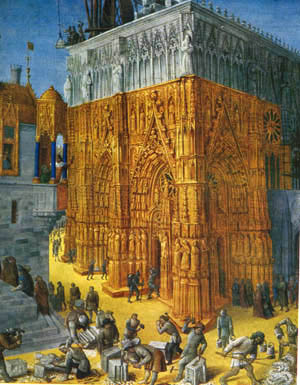
The medieval man conceived society as the building of the earthly Jerusalem, made in the likeness of Heaven |
The word revolution means first, to turn up-side-down something that is in order, and second to establish in its place another reality that is the opposite of it, which is disorder.
What did this Revolution seek to subvert? It was the Reign of Christ, Christendom, that was established in Western Europe in the Middle Ages.
The truths of Revelation can do more than just organize the Catholic Church and provide guidance for souls to reach Heaven. When the Church has a great influence in an epoch, these Catholic truths surpass the limits of the ecclesiastical sphere and naturally extend to the temporal sphere. This influence tends to form a Catholic social and political order in countries where it is felt. When we have an ensemble of Catholic States that aspire to a higher unity to bring them together and express their spirit, they are seeking a Christendom. This word is normally understood as the temporal reign of Our Lord on earth.
In History there have been various attempts to establish Christendom, but only one succeeded and formed a fitting reflection of Jesus Christ in the temporal sphere. This occurred with the ensemble of States that formed Western Europe in the 12th and 13th centuries. Such an ensemble formed Medieval Christendom or simply, Christendom. The order it established effectively represented the establishment of the Kingdom of Christ on earth.
Referring to Medieval Christendom St. Pius X affirmed:
“Civilization does not need to be invented, neither the New City to be built in the clouds. It existed, it exists, it is the Christian Civilization, the Catholic City. We need only to establish it again and incessantly restore it on its natural and divine foundations against the always reborn attacks of the evil utopia, revolt and impiety, omnia instaurare in Christo [to restore everything in Christ]” (Notre Charge Apostolique, n. 11).
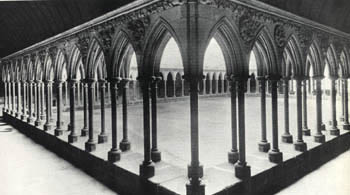
The cloister of the Mont St. Michel Abbey reflects the medieval harmony between religion and civil life |
Pope Leo XIII wrote these words about the Middle Ages:
“There was a time when the philosophy of the Gospel governed the States. In that epoch, the influence of Christian wisdom and its divine virtue permeated the laws, institutions, and customs of the peoples, all categories and all relations of civil society. Then the Religion instituted by Jesus Christ, solidly established in the degree of dignity due to it, flourished everywhere thanks to the favor of Princes and the legitimate protection of Magistrates. Then the Priesthood and the Empire were united in an opportune harmony and by the friendly interchange of good favors. So organized, civil society gave fruits superior to all expectations, and its memory subsists and will subsist, registered as it is in innumerable documents that no artifice of the adversaries can destroy or obscure” (Immortale Dei, n. 28).
The establishment of Medieval Christendom represented the installation of the Kingdom of Christ in the temporal sphere and, with this, the end of the hegemony of the Devil.
Indeed, after his sin Adam lost the kingdom that God had intended for him to implant on earth. The kingdom he lost was taken over by the one who defeated Adam, the Devil, who with Adam’s sin acquired an enormous power over nature and human society. For this reason one can find in the great empires of Antiquity, such as those of Assyria, Egypt, Greece, and Rome, the notable influence of the Devil in the idolatry of most of the ancient religions. Scripture states that all the gods of those religions were devils: “Omnes dii gentium sunt daemonia” (Psalm 95:5).
The Redemption of Our Lord made amends for the sin of Adam. After the Death and Resurrection of Jesus Christ, men were able to enter Heaven and see God face-to-face. The naissance of the Church initiated the New Covenant. But the temporal sphere remained under the power of the Devil. This explains in part the furor of the Roman Empire against the newborn Church.
From the 5th century on, with the conversion of the barbarians, many States became Catholic, the seedbed for what would become Medieval Christendom in the 12th and 13th centuries. Christendom represented for the first time in History the victory of Our Lord over an ensemble of States, those of Europe. Therefore, since Our Lord was victor in the religious and temporal spheres, the establishment of Medieval Christendom represented the complete re-conquering of Jesus Christ over the Devil after the original sin of Adam.
The principal characteristics of Medieval Christendom were humility and temperance. Humility, as a social virtue, means to love one’s place in the hierarchy of society, and to venerate the ensemble of the social and political hierarchy as a reflection of God. Temperance in the social sphere means submission to and respect for the rules of society, be they moral rules or disciplinary norms, which act as proper means to lead the social body to build the Reign of Christ. In another study I plan to deal with the way these two social virtues of humility and temperance truly molded Christendom, and how the magnificent social edifice that resulted was a worthy reflection of God.
Evil was defeated, but not for long. The Devil and his cohorts schemed to destroy Medieval Christendom and establish the precise opposite on earth. This aim constitutes the essence of the Revolution. As far as Medieval Christendom can be said to represent the establishment of order par excellence, the Revolution signifies the inversion of this order. This is the most profound meaning of Revolution.
Other characteristics of the Revolution
The agents of the Revolution are generically the forces that serve the Devil, with a particular emphasis upon two of them that have a special hatred for the Church: Judaism, understood as a religion and not as a race, and Freemasonry.

Like the large and venomous snake above, the action of the secret forces is camouflaged everywhere in society. The the naive don't see the danger, and don't believe in a conspiracy against Christendom. National Geographic, August 2004 |
Regarding individuals, these agents not only conspire and act externally but also internally. In their plan to destroy the Catholic order they utilize as natural allies the ungoverned bad tendencies of the human soul. The secret forces stimulate human vices in order to exacerbate them and also to attain the revolutionary goals. The principal forces of propulsion for the Revolution inside the soul are the ungoverned tendencies of pride and sensuality.
Pride is the vice that opposes humility. In the social sphere, pride is the revolt against hierarchy. It is to revolt against one’s place in society, to not accept a superior over oneself. Even more than that, it is to reach a kind of metaphysical degree of hatred, affirming that superiority and hierarchy per se are bad. Everything should be equal. Egalitarianism is set up as a metaphysical principle.
Sensuality is the vice that opposes temperance. Its social reflex is to counter the rules that govern society – either moral rules or disciplinary norms. Here also there are two layers: in the first layer the person hates the yoke of rules because he cannot do the bad things he wants; in the second deeper layer, he goes further to a metaphysical level of hatred and denies any rule whatsoever. Everything should be free. Liberty is proclaimed as an absolute value.
When someone reaches one of these two metaphysical levels of hatred, or both of them, one can say that he committed the sin of Revolution. That is to say, he committed a particular sin against the Kingdom of Christ on earth, and consciously or unconsciously became an active agent of the Revolution. This is true regardless of whether or not a person is a Jew, Mason, or member of other similar secret forces.
The Revolution acts in three different levels of human activities. It intensively tries to model the tendencies of the human soul, then the ideas of the human mind, and finally the facts of human behavior. Normally in a well-ordered soul the actions a man makes are a translation of the ideas he has; and his ideas were born from the tendencies he has permitted to take root inside his soul.
For example: Even before a man from the Renaissance began to live with the arts, pleasures and luxury as the center of his life, he had adhered to the ideas of Humanism, which places man at the center of everything. And before accepting those ideas, he became weary of always considering God as the center of his attention and the object of all the glories of man. This ennui with the Lordship of God and the correspondent tedium with observing His austere law were tendencies promoted by the Revolution in the soul of the medieval man to pave the way for the ideas of Humanism and installation of a new way of living: the Renaissance. With this we have an example of how the tendencies produce the ideas, and how the human acts proceed from those ideas.
This process of tendencies-ideas-facts in a man translates to society as the tendencies that begin to appear in the customs, the ideas that then start to circulate, and, finally the facts that result from them: tendencies-ideas-facts.
This process is also called the revolutionary process. It started to be applied as soon as the Revolution was born in the Middle Ages. Its main characteristic is that in each of its cycles, the facts – the last phase – open the doors for new bad tendencies that will give birth to new bad ideas; from these come new revolutionary facts and the process repeats itself. The successive cycles of the revolutionary process have produced certain milestones of the Revolution in History. They are the following:
Humanism in man’s way of being and the Renaissance in the arts established new models for the medieval man, ones that clashed with the sacral and hierarchical model he previously had. With Humanism, the Revolution presented man as the measure of everything so as to break the stability of man’s former way of thinking, which considered God and the Catholic Religion as the measure of everything. With the Renaissance, Greek and Roman cultures were presented as models for the arts. The Renaissance spirit exalted beauty (pulchrum) to the detriment of morals (bonum) and the truth (verum), which from then on was no longer considered absolute but relative. Also the austerity of medieval man, characterized by the love of the Cross, was broken. It was replaced by an exaggerated desire and quest for pleasures. The open literary disputes about philosophy and religion, which held up pagan philosophers as paradigms, helped to pave the way for Protestant free-examination.
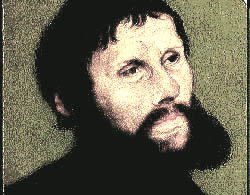
Protestantism represented a new explosion of pride and sensuality. Above, Martin Luther |
The principal fact of Humanism and the Renaissance – which is the denial of the primacy of God in all of life – opened the door to the tendency of denying the role of the Pope in the Church, which then became an idea. This idea, in its turn, became a fact with the Protestant Revolution. It brought as a consequence the fracture of Christendom, and the introduction into it of a powerful element of destruction. The inevitable religious wars of the 16th century would seal the division of Christendom.
What are the roles of pride and sensuality in this process? As an explosion of pride, Protestantism denies Hierarchy. All its sects deny the Pope; some, like the Presbyterians, also deny Bishops, and others, like the Anabaptists, go further and deny the priesthood as well. The latter represent the most radical egalitarianism, analogous to the Communism that would come later in another cycle. As an explosion of sensuality, Protestantism finished with clergy celibacy, and introduced divorce in society, breaking the unity of the family. Protestantism showed itself to be a sycophant of the Princes, and the Protestant sects became subordinate to the State. With this, the sovereignty of the religious sphere was undermined.
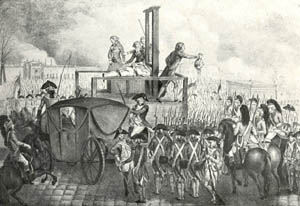
The beheading of Louis XVI symbolized the end of Ancien Regime in the temporal sphere. It is analogous to the abolishing of the Papacy in the spiritual sphere by the Protestant sects |
These facts, resulting from the bad ideas, stimulated new bad tendencies in society. The free-examination that was accepted in the religious sphere by Protestantism generated the exaltation of reason and the free-thinking of the Enlightenment, which paved the way for the French Revolution. The revolt against the Pope and ecclesiastical Hierarchy in the religious sphere became a revolt against the King and nobility in the civil sphere. The French Revolution destroyed the social and political remains of the Kingdom of Christ in France. And from France, the same principles spread throughout the West.
The French Revolution marked the beginning of the Modern World, with a new conception of State. According to its revolutionary principles, there should no longer be a Catholic State turned to the glory of God, but rather an inter-confessional State where the true and false religions should have the same rights before the law. Also Catholic Morals was abolished. A vague morality, based on a disputable interpretation of Natural Law, took its place. According to this system, a person should be free to do whatever he wants with regard to morals so long as he does not harm or disturb anyone else. That is, free morals was established on the individual level. Again we have pride and sensuality as the propelling forces of the French Revolution.
The hierarchical structure of Medieval Christendom was composed by three main classes: The Clergy, the nobility and the plebeian class. Protestantism attacked the Clergy as the first class, the French Revolution attacked nobility as the second class. The last one to be assailed was the plebian class, which had its own internal hierarchy and was composed by the bourgeoisie and people.
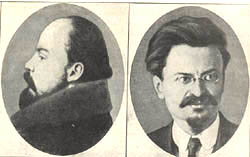
Lenin & Trotsky, the leaders of the Communist Revolution in Russia, 1917 |
Communism was the tool utilized by the Revolution to attack the difference that existed between the bourgeoisie and the people. It proclaimed that everything should belong to everyone: there should no longer be owners and bosses. The dictatorship of the proletariat was imposed. Communism also eliminated morals as something bourgeois. It openly preaches free-love. We know the great damage Communism caused in Russia and the countries of the old USSR from 1917 to 1989. I don’t agree with the fable being spread that Communism has died. It continues to be in power as such – in Russia and the Ukraine, for example – or is disguised under new names in several Eastern European countries. It retains its old clothing and style in other countries like China, Vietnam, North-Korea, and Cuba. It is also expanding to Catholic countries as, for example, with the recent presidential electoral victory of the communist Lula in Brazil.
Even in the countries where Communism does not exert direct political control, its ideas have infiltrated everywhere, as foretold by Our Lady at Fatima. Those ideas are expressed in the socialist tendencies of the Western democracies, in which one can easily discern the influence of communist ideals and goals. With regard to employers and employees, owners and tenants, teachers and students, men and women, and even parents and children, the Western legislation continuously favors the egalitarianism preached by Communism.
These three blows against Christendom – Protestantism, the French Revolution, and Communism – in effect spelled its political ruin. Almost nothing remains of the Kingdom of Christ as it was. But some social reflexes of that salutary past still existed. They were the good customs and traditions that were the fruit of the excellent influence of the Catholic Church on society. For example: there still remained the habits of dressing with distinction, conversing and speaking with politesse, and carrying oneself and behaving in a dignified way.
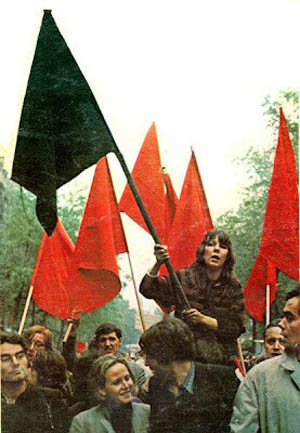
May 1968, Paris. The black flags of Anarchism carried along with the red flags of Communism. Two steps of the same revolutionary process. ICI, July 1968 |
The Revolution struck at these remnants with the Cultural Revolution, or the Revolution of 1968 in the Sorbonne and Berkeley. This was the beginning of a change in the way of being of man with regard to politesse, dignity and purity. An avalanche of vulgarity, bad taste and immorality fell over the world.
This revolution in the customs was accompanied by a denial of any form of law and authority. One of the principal slogans in the revolt of the Sorbonne was: “It is forbidden to forbid!” This translates simply to: No more authority, no more law. It was absolutely anarchist.
It also disseminated new ideas, a new philosophy, a new concept of man and society that is called Structuralism. According to it, a man should no longer claim for himself an individual thinking, will, and sentiment, but should share the collective thinking, will, and sentiment of the elementary social unit he belongs to. The elementary structure of this new system took its inspiration from the Indian tribes. A new urban tribalism was introduced, and its influence can be noted everywhere today with the new communitarian feeling that is being promoted and adopted everywhere. One has to think, desire, and feel what his small group thinks, desires, and feels, be that group a gang, a football fan club, or a small religious cell. The latter would be the basic Christian communities that are being widely promoted by the progressivist Church.
This revolution is also changing economics by presenting the model of self-managed small enterprises to replace the present-day capitalist system. It is a radical socialism, more advanced than Communism, since it is designed to go to the next phase after the dictatorship of the proletariat, the so-called final synthesis dreamed of by Marx and other ideologues.
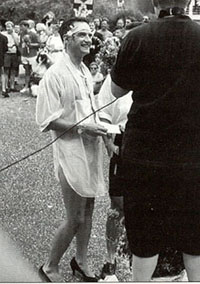
A homosexual "marriage" in Boston. Catholic World Report, July, 1997 |
Regarding morality, this Cultural Revolution is absolutely libertarian. It supposes a complete tribal free-love. In the last 30 years the free-morality it preached had little-by-little expanded over the West. Today the customs are completely changed, morality has almost disappeared, free-love is practically installed, and we are witnessing the unimaginable: the concession that homosexuals be treated as normal citizens, and even the radical measure of the so-called homosexual marriages.
The victory of the Revolution seems complete. That is, the Reign of Christ is almost totally destroyed and the plan of the Devil realized. The reign of the Devil and his agents is installed over the ruins of Christendom.
This is the historical overview of the revolutionary process as the destruction of the temporal Reign of Jesus Christ.
Before dealing briefly with the Counter-Revolution, let me point out how the Revolution is attacking the Catholic Church. This will give us an idea of where the weak points are in this centuries-old process, and will show that we can still stop it and restore Christendom.
The Catholic Church and the Revolution
The revolutionary process, properly speaking, is what I just finished describing. That is, it was directed against Christendom, not against the Catholic Church.
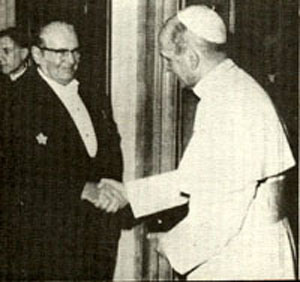
Paul VI receiving communist dictator Tito at the Apostolic Palace, Vatican, March 29, 1971 - Estado de Sao Paulo, March 30, 1971 |
The fight of the Devil and his cohorts against the Catholic Church in her History has consisted in launching persecutions, like the ten Roman persecutions, and then stimulating heresies. This was, of course, in addition to his continuous preternatural efforts to tempt individuals and cause them to lose their souls.
Through the centuries the Revolution was able to change certain tendencies and ideas inside the Church, but it had not yet touched her institutions, which remained structurally and essentially the same as they were in the late Medieval Ages and Renaissance. To change the institutions of the Church and adapt them to the Revolution, it was necessary to stage a great event: Vatican Council II.
When Vatican II called for an adaptation of the Church to the Modern World, what it was saying is that the Church needed to adapt herself to the Revolution in the world. This adaptation was begun by the Council in the ‘60s, and has been carried out systematically in the last 40 years.
In summary, with the process of the Revolution that we have just seen, the Devil re-conquered the world for himself, and now he is trying to take and win the Catholic Church in order to inflict a complete defeat on Our Lord Jesus Christ. Should he succeed, the Redemption would be rendered futile, which we know is impossible.
This is the panorama we are witnessing today with regard to the aims and progress of the Revolution.
There is, however, an important addendum that can change the whole picture.
The weak point of the Revolution
The Revolution has been working tirelessly and systematically to destroy Christendom since at least the 14th century, that is, for six centuries. Now it is trying to accomplish an analogous work inside the Church in only 40 years. This implies, therefore, the need for a considerable acceleration in its speed.
However, one of the secrets of the victory of the Revolution in each of its historical phases was that it always allowed sufficient time for public opinion to gradually absorb the novelties that each phase introduced. Without the accord of public opinion, the Revolution cannot go forward in its march. It would lose its footing, its base in reality, and shortly would become a mere utopia. The way for the Protestant Revolution, as we saw, was slowly prepared by Humanism and the Renaissance. That preparation in the tendencies, ideas, and facts took around two centuries to be executed successfully. The same happened regarding the other three phases – the French Revolution, Communism, and the Cultural Revolution.
Now, regarding the Conciliar Revolution in the Church, Progressivism is facing the urgent situation of changing the entire face of the Church at a rapid-fire pace, acting with a stunning speed. This hasty procedure of making the Revolution advance inside the Church can cause critical embarrassment for its agents, because it runs the risk of having Catholic public opinion react strongly against the proposed novelties. If such a reaction should occur, the Revolution would need to stop and continue at a slower speed. But for many reasons that could be explained later, the Revolution does not have the time to wait for a slow and methodical absorption of the Conciliar Revolution. Therefore, we discover a weak point in the process. If this would be well exploited by us, it can become the point by which Revolution could be defeated in the Catholic Church.
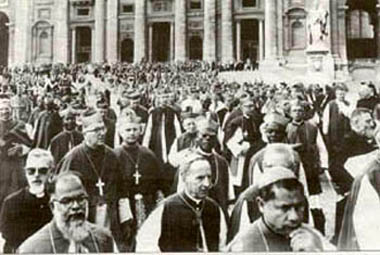
Vatican II made a high-speed revolution in the Catholic Church. There is a great risk of a general crystallization among Catholics. Above, Bishops leaving the St. Peter Basilica during the Council. - The Tidings October 25, 2002 |
When Vatican Council II was announced, Catholic public opinion was not sufficiently prepared in either the tendencies or the ideas to receive its novelties. For countless Catholics the reforms of the Council were a surprise and a shock. Normally they would have strongly rejected it. They only accepted the Conciliar Revolution because of the weight of two Popes – John XXIII and Paul VI – and the some 2,400 Bishops who approved it. Until today the Council is accepted principally because of the support of four Popes and almost all the Bishops of these last 40 years.
Parallel to this massive appeal to authority to make the faithful swallow the Council, a kind of anesthesia has also been applied. One of its main factors is that the Catholic faithful must accept the never-ending novelties without any discussion. Above all, no public discussion! A good example of how this is applied can be found in the Ecclesia Dei Commission, which is the Vatican organ that gives permission to celebrate the Tridentine Mass. It demands a written promise from the priest who submits an application to never raise a public polemic about the Council or the New Mass. The priest is allowed to say the Tridentine Mass, but he is forbidden to raise a public discussion – or even a simple protest – about either the Council or the New Mass. That is to say, above all the Vatican fears a public polemic on these points.
Why? Because, should a public controversy take place on an open playing field, it would become clear that the four Popes who supported the Council and the post-Council novelties clearly took positions against the almost 2000 years of uniform and consistent teaching of the previous Popes, affirming precisely the opposite. Also the broad scale apostasy of the Bishops from the time of the Council to our days would become clear, and the crystallization of the faithful against this betrayal could easily turn the reaction to an en masse phenomenon. A phenomenon that would reject the Council and demand a return to tradition.
Therefore, the weak point of the Revolution today is the public controversy regarding Vatican II and the New Mass inside the Catholic Church.
It is not my intention to set out in any detail here a plan on how to destroy the Revolution in the Church, and as a consequence, the whole process of the Revolution. In a tape named “How to Stop the Conciliar Revolution” I presented some points for that. Also, it is not my purpose to describe here the counter-revolutionary principles to restore a new Christendom.
Here I intend only to stress that the Revolution did not conquer inside the Church. And I also want to emphasize that it will not win. This is a closed question. If it were to conquer, the divine promise of Our Lord to always protect the Church would be violated, which is impossible. Therefore, we are called to this glorious fight in this privileged moment of History. We are called to join our forces to defeat the Revolution inside the Church, and doing this, to frustrate the entire revolutionary process.
There is only one point that still needs some explanation in this paper: What is the Counter-Revolution?
A brief outline of the Counter-Revolution
The Counter-Revolution is a reaction against Revolution. A reaction to every aspect of the Revolution. To its very essence, as well as to its sources, goals, strategies, methods, means and agents.
To explain each of these points would take a long time. God willing, I plan to do so in the future.
Let me only give you an example. I will apply the notion of Counter-Revolution to the conservative and traditionalist milieus in order to clarify what it means in this respect.
What is the difference between a conservative, a traditionalist, and a counter-revolutionary?
Normally, a conservative is understood as someone who wants to conserve what he has by a question of habit. So, in face of the Revolution in the Church that changes everything, he opposes part of it because it breaks his habits and destroys what he is comfortable with. His opposition, however, does not have deep roots because it is not supported by principles. For this reason, with the passing of time, the conservative shifts little by little to the left. Yesterday, for example, he was opposed to pop music in the churches, today he approves the Masses with rock ‘n’ roll at the World Youth Days.
The traditionalist is a person who in face of the changes in the Church – Vatican II, the new Morals, the New Mass, the new liturgy, etc – wants to return to the time before Vatican II. That is, to the time when tradition was respected and there were good Morals, good customs, pious churches and devotions, the Tridentine Mass, of course, and many other salutary things. To return to this ideal, some want to go back to the time of Pius XII, others to the time of Pius XI, others even further. But even if they are inspired by principles, they do not see the entire picture. They do not place themselves inside the scenario of a centuries-old fight.
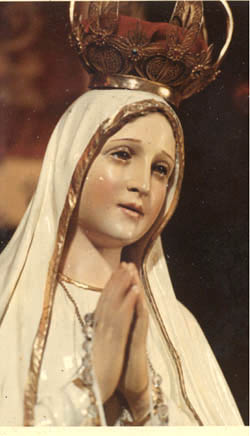
Our Lady is the Queen of the
Counter-Revolution. She will triumph over the present day crisis in the Church, as she predicted in Fatima |
The counter-revolutionary is that person who, in face of the modern changes in the Church, wants to destroy the very source of these changes. He sees the changes as being the goal of a bad current – Progressivism – which is the heir of another bad current – Modernism – which was the heir of Liberalism. In its turn, Liberalism was linked to a whole ensemble of other currents that were inspired and supported by groups and associations that always worked and fought against the Catholic Church and Christendom. This movement is the Revolution.
So, the counter-revolutionary is that person who sees the whole Revolution behind the present-day changes in the Church and wants to destroy it. He wants to establish in the Church and in the civil society the very opposite of what the Revolution desires. This would be an order that would be traditional, but it is a kind of traditionalism that is always in the militant position of counter-attack against evil.
Therefore, although the three can work together, conservatives, traditionalists and counter-revolutionaries have different degrees of depth and efficacy in their positions.
A good and widespread tendency that exists today in the United States is for conservatives to become traditionalists, and for traditionalists to become counter-revolutionaries. To foster such a good tendency is one of the reasons for this paper. It aims to reveal the real enemy behind the scenes – the Revolution – so that the ranks of the counter-revolutionaries committed to an efficient action will increase.
I thank Our Lady for the fact that these ranks are increasing. It is clear that she is working in souls in order to give the victory to the Counter-Revolution and establish a new Christendom, which will be the Reign of her Immaculate Heart that she announced at Fatima.

Posted September 23, 2004

Related Topics of Interest
 Philosophy and Theology of History Philosophy and Theology of History
 Counter-Revolutionary Personalities Counter-Revolutionary Personalities
 Revolution and Counter-Revolution in the Tendencies, Ideas and Facts Revolution and Counter-Revolution in the Tendencies, Ideas and Facts
 Defending the Crusades Defending the Crusades
 The Swan's Song of Galileo's Myth The Swan's Song of Galileo's Myth
 The Personality of Charlemagne The Personality of Charlemagne

Related Works of Interest
|